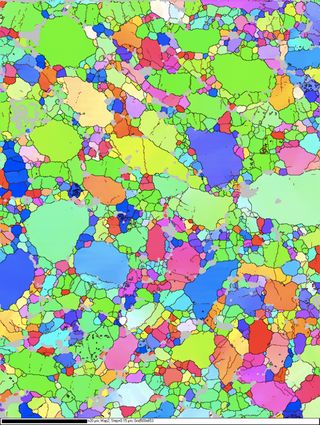
Tiny Crystal Defects Help Drive Plate Tectonics

Inside most of the Earth, olivine is a hot mineral whose creepy behavior drives plate tectonics.
In the upper mantle — the top of the planetary layer between the crust and core — olivine's unusual behavior presents a paradox. These solid crystals must change shape for plate tectonics to work, oozing like toothpaste over long time scales. (The mantle's flow helps push and pull Earth's crustal plates.)
By mimicking the extreme pressures and temperatures of the mantle in a laboratory, scientists have found that olivine crystals move by contorting along internal defects. The defects allow one part of a crystal to slip and slide (or shear) over another part. That's how a single crystal morphs without breaking. The paradox? There's a missing defect. According to models, Earth's mantle flows in such a way that there should be three independent directions of movement for olivine crystals. But until now, researchers had found only two, said Patrick Cordier, a geophysicist at the University of Lille in France.
"Olivine shows only defects along two directions, not three," Cordier said. "This is not enough for achieving a general deformation. However, olivine-rich natural rocks show pervasive evidence suggesting that olivine deforms very easily in the mantle."
Cordier and his colleagues recently discovered a new kind of olivine crystal defect, one that could explain the paradox. The findings were published Feb. 26 in the journal Nature.
With an advanced electron microscopy technique, the researchers saw linear defects, called dislocations, at the boundaries between olivine crystals. The dislocations let individual crystals slide past one another. Malleable metals also have similar dislocations, which is why jewelry makers can bend and twist gold and silver into beautiful shapes. [50 Amazing Facts About Earth]
"Dislocations allow crystals to be sheared along some specific directions and on some specific planes," Cordier said. "If a crystalline solid has enough different kinds of those defects, it can exhibit an ability to deform which seems to ignore its crystalline structure. This is the case for metals. This is also the case for minerals and rocks," he told Live Science's Our Amazing Planet.
Sign up for the Live Science daily newsletter now
Get the world’s most fascinating discoveries delivered straight to your inbox.
More work is needed before geoscientists will know whether the new discovery resolves the olivine paradox, said Greg Hirth, a geophysicist at Brown University who was not involved in the study. However, the study marks the first time dislocations have been discovered in geological materials, and will further understanding of the processes that control the mantle, Hirth said in a commentary on the findings that was also published in Nature.
Email Becky Oskin or follow her @beckyoskin. Follow us @OAPlanet, Facebook and Google+. Original article at Live Science's Our Amazing Planet.

Most Popular

